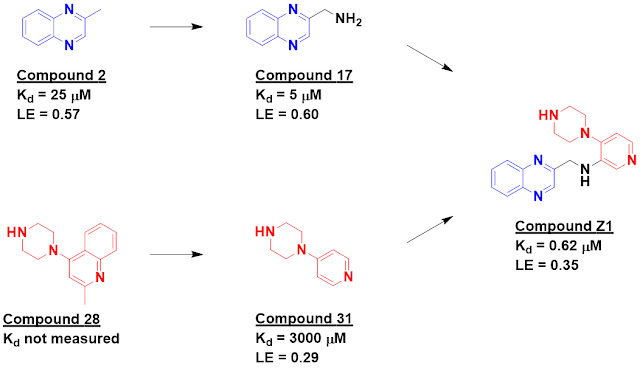Of the roughly 150,000 crystal
structures in the Protein Data Bank (PDB), about 94% were collected at
cryogenic temperatures (≤ 200 K), typically after being frozen in liquid nitrogen.
Frozen crystals are easier to store and transport and can better survive bombardment
by intense X-rays, but are the resulting structures still physiologically
relevant? A newly published open-access paper by Daniel Keedy (CUNY) and a
multinational team of collaborators suggests caution.
The researchers were interested
in the protein tyrosine phosphatase PTP1B, a diabetes target that has implacably
thwarted generations of drug hunters. A previous screen had identified dozens
of fragments that bound at cryogenic temperatures to multiple sites on the protein,
most prominently the active site and three secondary sites. In the new work,
143 fragments were chosen for reanalysis at room temperature, of which more
than half were hits and the rest were non-hits that had been included in the
previous screen. The goal was to assess whether the same fragments would bind
in the same manner, and whether any of the non-hits would bind at room temperature.
Two methods were used for
room-temperature crystallography. In both cases, fragments were soaked into
crystals of PTP1B. In the first, crystals were harvested from drops as normal,
but rather than being flash frozen they were enclosed in plastic capillaries to
keep them hydrated. The second “in situ” method was performed by mounting the
crystallization trays directly onto the goniometer at the synchrotron.
Both methods gave similar
results, though the average resolution for the in situ method (1.99 Å) was
better than the capillary method (2.30 Å) and even surpassed the previous cryo
screen (2.10 Å). Fragment hits were initially identified using the automated PanDDA
method (see here), followed by manual analysis and careful data processing to
ensure that even the weakest binders were not overlooked.
Surprisingly, the hit rate was
quite low: only about a third of the fragment hits that had been identified under
cryogenic conditions were found in the screen at ambient temperature. Moreover,
the room-temperature fragments tended to have lower occupancy factors, meaning
that a higher fraction of a given binding site was empty. The researchers took
special care to ensure that the results were robust, for example by checking to
make sure that fragments had been correctly added to the droplets.
Of the fragments that confirmed,
the binding modes often differed, for example by flipping 180°. In some cases
water molecules around the fragment varied depending on the temperature; as we’ve
written, water can be essential for binding interactions, so these
differences could be significant. And in some cases the room-temperature fragments
bound to different sites entirely, including one site that had not been
observed to bind any fragments under cryogenic conditions.
Only one of the fragments that
had previously not produced hits under cryogenic conditions showed up as hit at
room temperature, but interestingly this one formed a covalent bond to two
different lysine residues.
So what are we to make of all
this? The researchers speculate that the overwhelming focus on cryogenic
structures “may favor protein-ligand interactions that overweight enthalpic
considerations and underweight entropic ones, feature inaccurate solvation
environments, or suggest artificially rigid proteins.” The fact that most machine-learning
models of protein-ligand interactions are trained on cryogenic structures may systematically
bias their results.
In 2016 we highlighted an argument
for moving crystallography to the front of a screening cascade, but as we noted
last year doing so may lead to myriad hits too weak to advance. Perhaps room temperature
crystallography can bridge this gap.



